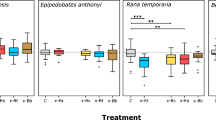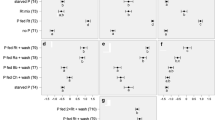Abstract
In aquatic environments, chemical cues are believed to be associated with prey response to predation risk, yet few basic cue compositions are known despite the pronounced ecological and evolutionary significance of such cues. Previous work indicated that negatively-charged ions of m/z 501 are possibly a kairomone that induces anti-predator responses in amphibian tadpoles. However, work described here confirms that this specific ion species m/z 501.2886 is produced by injured tadpoles, exhibits increased spectral intensity with higher tadpole biomass, and is not produced by starved predators. These results indicate the anion is an alarm cue released from tadpoles. High resolution mass spectrometry (HR-MS) revealed a unique elemental composition for [M-H]−, m/z 501.2886, of C26H45O7S− which could not be determined in previous studies using low resolution instruments. Collision induced dissociation of m/z 501 ions formed product ions of m/z 97 and m/z 80, HSO4− and SO3−, respectively, showing the presence of sulfate. Green frog tadpoles, Lithobates clamitans, exposed to the m/z 501 anion or sodium dodecyl sulfate exhibited similar anti-predator responses, suggesting organic sulfate is a tadpole behavior modifier.








Similar content being viewed by others

References
Abraham R, Mobli M (2008) Modelling 1H NMR spectra of organic compounds: theory, applications and NMR prediction software. Wiley, Chichester
Alemadi S, Wisenden B (2002) Antipredator response to injury-released chemical alarm cues by convict cichlid young before and after independence from parental protection. Behaviour 139:603–611
Blackwell E, de Leon CFM, Miller GE (2006) Applying mixed regression models to the analysis of repeated-measures data in psychosomatic medicine. Psychosom Med 68:870–878. https://doi.org/10.1097/01.psy.0000239144.91689.ca
Blumstein DT, Barrow L, Luterra M (2008) Olfactory predator discrimination in yellow-bellied marmots. Ethology 114:1135–1143. https://doi.org/10.1111/j.1439-0310.2008.01563.x
Brown GE, Adrian JC, Smyth E, Leet H, Brennan S (2000) Ostariophysan alarm pheromones: laboratory and field tests of the functional significance of nitrogen oxides. J Chem Ecol 26:139–154
Cakir Y, Strauch SM (2005) Tricaine (MS-222) is a safe anesthetic compound compared to benzocaine and pentobarbital to induce anesthesia in leopard frogs (Rana pipiens). Pharmacol Rep 57:467–474
Chivers D, Kiesecker J, Marco A (1999) Shifts in life history as a response to predation in western toads (Bufo boreas). J Chem Ecol 25:2455–2463
Chivers DP, Dixson DL, White JR et al (2013) Degradation of chemical alarm cues and assessment of risk throughout the day. Ecol Evol 3:3925–3934. https://doi.org/10.1002/ece3.760
Dupuch A, Magnan P, Dill L (2004) Sensitivity of northern redbelly dace, Phoxinus eos, to chemical alarm cues. Can J Zool 82:407–415. https://doi.org/10.1139/Z04-003
El-Balaa R, Blouin-Demers G (2013) Does exposure to cues of fish predators fed different diets affect morphology and performance of Northern Leopard Frog (Lithobates pipiens) larvae? Can J Zool 91:203–211
Ferland-Raymond B, March RE, Metcalfe CD, Murray DL (2010) Prey detection of aquatic predators: assessing the identity of chemical cues eliciting prey behavioral plasticity. Biochem Syst Ecol 38:169–177. https://doi.org/10.1016/j.bse.2009.12.035
Ferrari MCO, Messier F, Chivers DP (2008) Degradation of chemical alarm cues under natural conditions: risk assessment by larval woodfrogs. Chemoecology 17:263–266. https://doi.org/10.1007/s00049-007-0381-0
Ferrari MCO, Wisenden BD, Chivers DP (2010) Chemical ecology of predator–prey interactions in aquatic ecosystems: a review and prospectus. Can J Zool 88:698–724. https://doi.org/10.1139/Z10-029
Ferrero DM, Liberles SD (2010) The secret codes of mammalian scents. Wiley Interdiscip Rev Syst Biol Med 2:23–33. https://doi.org/10.1002/wsbm.39
Folch J, Lees M, Sloane-Stanley G (1957) A simple method for the isolation and purification of total lipids from animal tissues. J Biol Chem 226:497–509
Fraker M (2009) Perceptual limits to predation risk assessment in green frog (Rana clamitans) tadpoles. Behaviour 146:1025–1036. https://doi.org/10.1163/156853909X404439
Fraker ME, Hu F, Cuddapah V et al (2009) Characterization of an alarm pheromone secreted by amphibian tadpoles that induces behavioral inhibition and suppression of the neuroendocrine stress axis. Horm Behav 55:520–529. https://doi.org/10.1016/j.yhbeh.2009.01.007
Gosner K (1960) A simplified table for staging anuran embryos and larvae with notes on identification. Herpetologica 16:183–190
Hagman M, Shine R (2009) Larval alarm pheromones as a potential control for invasive cane toads (Bufo marinus) in tropical Australia. Chemoecology 19:211–217. https://doi.org/10.1007/s00049-009-0027-5
Hettyey A, Tóth Z, Thonhauser KE et al (2015) The relative importance of prey-borne and predator-borne chemical cues for inducible antipredator responses in tadpoles. Oecologia 179:699–710. https://doi.org/10.1007/s00442-015-3382-7
Hettyey A, Thonhauser KE, Bókony V et al (2016) Naive tadpoles do not recognize recent invasive predatory fishes as dangerous. Ecology 97:2975–2985. https://doi.org/10.1002/ecy.1532
Ireland DH, Wirsing AJ, Murray DL (2007) Phenotypically plastic responses of green frog embryos to conflicting predation risk. Oecologia 152:162–168. https://doi.org/10.1007/s00442-006-0637-3
Iverson SJ, Lang SLC, Cooper MH (2001) Comparison of the bligh and dyer and folch methods for total lipid determination in a broad range of marine tissue. Lipids 36:1283–1287. https://doi.org/10.1007/s11745-001-0843-0
Jara FG, Perotti MG (2010) Risk of predation and behavioural response in three anuran species: influence of tadpole size and predator type. Hydrobiologia 644:313–324. https://doi.org/10.1007/s10750-010-0196-9
Jensen S, Häggberg L, Jorundsdottir H, Odham G (2003) A quantitative lipid extraction method for residue analysis of fish involving nonhalogenated solvents. J Agric Food Chem 51:5607–5611
Katta V, Chait BT (1993) Hydrogen/deuterium exchange electrospray ionization mass spectrometry: a method for probing protein conformational changes in solution. J Am Chem Soc 115:6317–6321. https://doi.org/10.1021/ja00067a054
Kelly J, Adrian JC, Brown G (2006) Can the ratio of aromatic skeletons explain cross-species responses within evolutionarily conserved Ostariophysan alarm cues?: testing the purine-ratio hypothesis. Chemoecology 16:93–96. https://doi.org/10.1007/s00049-005-0333-5
Kiesecker J, Chivers D, Blaustein A (1996) The use of chemical cues in predator recognition by western toad tadpoles. Anim Behav 52:1237–1245
Laurila A, Kujasalo J, Ranta E (1997) Different antipredator behaviour in two anuran tadpoles: effects of predator diet. Behav Ecol Sociobiol 40:329–336. https://doi.org/10.1007/s002650050349
Laurila A, Kujasalo J, Ranta E (1998) Predator-induced changes in life history in two anuran tadpoles: effects of predator diet. Oikos 83:307–317. https://doi.org/10.2307/3546842
Mann RS, Rouseff RL, Smoot JM et al (2011) Sulfur volatiles from allium spp. affect Asian citrus psyllid, Diaphorina citri Kuwayama (Hemiptera: Psyllidae), response to citrus volatiles. Bull Entomol Res 101:89–97. https://doi.org/10.1017/S0007485310000222
Marcus J, Brown G (2003) Response of pumpkinseed sunfish to conspecific chemical alarm cues: an interaction between ontogeny and stimulus concentration. Can J Zool 81:1671–1677. https://doi.org/10.1139/Z03-165
Mathuru AS, Kibat C, Cheong WF et al (2012) Chondroitin fragments are odorants that trigger fear behavior in fish. Curr Biol 22:538–544. https://doi.org/10.1016/j.cub.2012.01.061
McCauley E, Nisbet RM, Murdoch WW et al (1999) Large-amplitude cycles of Daphnia and its algal prey in enriched environments. Nature 402:653–656. https://doi.org/10.1038/45223
McCollum SA, Leimberger JD (1997) Predator-induced morphological changes in an amphibian: predation by dragonflies affects tadpole shape and color. Oecologia 109:615–621. https://doi.org/10.1007/s004420050124
Meuthen D, Baldauf SA, Thünken T (2014) Evolution of alarm cues: a test of the kin selection hypothesis. F1000Research 1:1–13. Doi: https://doi.org/10.12688/f1000research.1-27.v1
Mirza R, Chivers D (2001a) Are chemical alarm cues conserved within salmonid fishes? J Chem Ecol 27:1641–1655
Mirza RS, Chivers DP (2001b) Chemical alarm signals enhance survival of brook charr (Salvelinus fontinalis) during encounters with predatory chain pickerel (Esox niger). Ethology 107:989–1005. https://doi.org/10.1046/j.1439-0310.2001.00729.x
Mirza R, Chivers D (2003) Response of juvenile rainbow trout to varying concentrations of chemical alarm cue: response thresholds and survival during encounters with predators. Can J Zool 95:88–95. https://doi.org/10.1139/Z02-216
Mitchell MD, Cowman PF, McCormick MI (2012) Chemical alarm cues are conserved within the coral reef fish family Pomacentridae. PLoS One 7:e47428. https://doi.org/10.1371/journal.pone.0047428
Miyakawa H, Imai M, Sugimoto N et al (2010) Gene up-regulation in response to predator kairomones in the water flea, Daphnia pulex. BMC Dev Biol 10:45. https://doi.org/10.1186/1471-213X-10-45
Nodari F, Hsu F-F, Fu X et al (2008) Sulfated steroids as natural ligands of mouse pheromone-sensing neurons. J Neurosci 28:6407–6418. https://doi.org/10.1523/JNEUROSCI.1425-08.2008
Otte D (1974) Effects and functions in the evolution of signaling systems. Annu Rev Ecol Syst 5:385–417. https://doi.org/10.1146/annurev.es.05.110174.002125
Pinheiro J, Bates D, DebRoy S, Sarkar D and R Core Team (2017) nlme: linear and nonlinear mixed effects models. R package version 3.1–131, https://CRAN.R-project.org/package=nlme
Pretsch E, Bühlmann P, Badertscher M (2009) 13C NMR spectroscopy. In: Structure determination of organic compounds, 4th edn. Springer Berlin Heidelberg, Berlin, pp 7–10
Rajchard J (2006) Antipredator pheromones in amphibians: a review. Vet Med (Praha) 51:409–413
Relyea R (2001) Morphological and behavioral plasticity of larval anurans in response to different predators. Ecology 82:523–540
Richardson JL (2006) Novel features of an inducible defense system in larval tree frogs (Hyla chrysoscelis). Ecology 87:780–787
Rittschof D, Cohen JH (2004) Crustacean peptide and peptide-like pheromones and kairomones. Peptides 25:1503–1516. https://doi.org/10.1016/j.peptides.2003.10.024
Scheffer M, Rinaldi S, Kuznetsov YA, van Nes EHA (1997) Seasonal dynamics of Daphnia and algae explained as a periodically forced predator-prey system. Oikos 80:519–532. https://doi.org/10.2307/3546625
Schoeppner NM, Relyea R (2005) Damage, digestion, and defence: the roles of alarm cues and kairomones for inducing prey defences. Ecol Lett 8:505–512. https://doi.org/10.1111/j.1461-0248.2005.00744.x
Schoeppner NM, Relyea RA (2009) Interpreting the smells of predation: how alarm cues and kairomones induce different prey defences. Funct Ecol 23:1114–1121. https://doi.org/10.1111/j.1365-2435.2009.01578.x
Smith R (1992) Alarm signals in fishes. Rev Fish Biol Fish 63:33–63
Sorensen PW, Scott AP, Stacey NE, Bowdin L (1995) Sulfated 17,20b-dihydroxy-4-pregnen-3-one functions as a potent and specific olfactory stimulant with pheromonal actions in goldfish. Gen Comp Endocrinol 100:128–142
Sorensen PW, Fine JM, Dvornikovs V et al (2005) Mixture of new sulfated steroids functions as a migratory pheromone in the sea lamprey. Nat Chem Biol 1:324–328. https://doi.org/10.1038/nchembio739
Steiger S, Schmitt T, Schaefer HM (2011) The origin and dynamic evolution of chemical information transfer. Proc Biol Sci 278:970–979. https://doi.org/10.1098/rspb.2010.2285
Trudeau VL, Schueler FW, Navarro-Martin L et al (2013) Efficient induction of spawning of Northern leopard frogs (Lithobates pipiens) during and outside the natural breeding season. Reprod Biol Endocrinol 11:14. https://doi.org/10.1186/1477-7827-11-14
Uchida H, Yasumoto K (2008) Time-of-flight LC/MS identification and confirmation of a kairomone in Daphnia magna cultured medium. In: Natural Product Chemistry. Agilent Tehchnologies Inc., USA, pp 1–6
Van Holthoon L, Van Beek TA, Lürling M et al (2003) Colony formation in Scenedesmus : a literature overview and further steps towards the chemical characterisation of the Daphnia kairomone. Hydrobiologia 491:241–254
Wang Z, Goonewardene LA (2004) The use of MIXED models in the analysis of animal experiments with repeated measures data. Can J Anim Sci 84:1–11. https://doi.org/10.4141/A03-123
Wisenden B (2008) Active space of chemical alarm cue in natural fish populations. Behaviour 145:391–407. https://doi.org/10.1163/156853908783402920
Yang S-W, Chan T-M, Pomponi SA et al (2003) Structure elucidation of a new antifungal sterol sulfate, Sch 575867, from a deep-water marine sponge (family: Astroscleredae). J Antibiot 56:186–189. https://doi.org/10.7164/antibiotics.56.186
Yasumoto K, Nishigami A, Yasumoto M et al (2005) Aliphatic sulfates released from Daphnia induce morphological defense of phytoplankton: isolation and synthesis of kairomones. Tetrahedron Lett 46:4765–4767. https://doi.org/10.1016/j.tetlet.2005.05.027
Yasumoto K, Nishigami A, Aoi H et al (2008) Isolation of new aliphatic sulfates and sulfamate as the Daphnia Kairomones inducing morphological change of a phytoplankton Scenedesmus gutwinskii. Chem Pharm Bull (Tokyo) 56:133–136
Yoshida T, Jones LE, Ellner SP et al (2003) Rapid evolution drives ecological dynamics in a predator-prey system. Nature 424:303–306. https://doi.org/10.1038/nature01767
Acknowledgements
This research was supported by the Natural Sciences and Engineering Council of Canada (NSERC), the Canadian Foundation for Innovation (CFI), the Ontario Research and Development Challenge Fund, and the Canada Research Chairs program. We are grateful to R. Webber for NMR laboratory work and S. Rafferty for helpful discussions.
Author information
Authors and Affiliations
Corresponding author
Electronic supplementary material
ESM 1
(DOCX 15 kb)
Rights and permissions
About this article
Cite this article
Austin, C.E., March, R.E., Stock, N.L. et al. The Origin and Ecological Function of an Ion Inducing Anti-Predator Behavior in Lithobates Tadpoles. J Chem Ecol 44, 178–188 (2018). https://doi.org/10.1007/s10886-018-0925-5
Received:
Revised:
Accepted:
Published:
Issue Date:
DOI: https://doi.org/10.1007/s10886-018-0925-5



